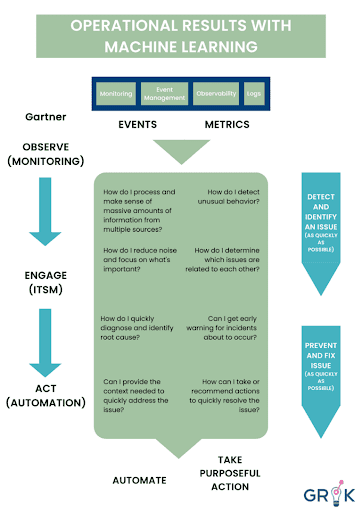The term “AIOps” stands for “artificial intelligence for IT operations”, and it refers to the use of machine learning and artificial intelligence to analyze various volumes of IT operations data to automate and optimize IT operations. With the use of different AIOps platforms, a lot of IT operations are enhanced and this is done through monitoring, automation, different insights and other data collection methods.
For businesses with vast and distributed computing infrastructures, one of the main objectives of IT and network operations is to locate the cause of a service condition that is having an impact. The more human resources are put into the task of gathering, processing, and finally visual monitoring the massive volumes of event and log data that serve as the main source of symptomatic indications for emerging crises, the closer the service is to the Company’s source of revenue.
Network management is being transformed by AIOps, as demonstrated recently by Enterprise Management Associates (EMA). According to this study, the majority of IT companies are aiming to achieve the following four objectives for AIOps-driven network management:
Even though several stages of incident detection can be automated, efforts to automate incident detection and response have been constrained by the enormous amount and diversity of logs and events that flow into the process. The significant work needed to design and maintain the rules at each tier of the process will be reduced by switching from fixed rules to a machine learning-based approach to incident detection. This process will expedite detection, lessen the amount of time needed to identify and manage issues, and ultimately put an end to them.
The use of unsupervised event clustering to automatically group all events connected to the same underlying cause (True Incident) and applying a supervised training loop to classify Incident patterns and associate handling information, such as a priority, root cause, suggested automation, etc. are two of the many contributions to this problem of event clustering with early incident detection.
Gartner defines AIOps as “Artificial Intelligence for IT Operations”
The IT operations processes of event correlation, anomaly detection, and causality determination are all automated by Grok by combining big data and machine learning, taking a page from Gartner in the process. Gartner’s stated categories of Monitoring, Engagement, and Action all experience higher results because to Grok.
Grok, in a nutshell, is the ability of AI and Machine Learning to enhance IT operations and procedures. As they deal with routine IT occurrences, IT teams are supported and strengthened by Grok.
The Gartner framework aids in describing Grok’s operation. Simply said, Grok’s AI and Machine Learning may assist in achieving the objectives of any organization’s Ops Team, which are to rapidly detect and proactively identify any threat or vulnerability and then promptly correct the flawed function to avoid further issues or event repetition.
In addition to identifying anomalous system behavior, Grok also gives early warning, muffles noise, classifies relevant dangers and vulnerabilities, and assigns causes. The Grok metacognitive model is composed of several behaviors, which are interrelated and portrayed as biologically analogous counterparts.
The Gartner framework aids in describing Grok’s operation. Simply said, Grok’s AI and Machine Learning may assist in achieving the objectives of any organization’s Ops Team, which are to rapidly detect and proactively identify any threat or vulnerability and then promptly correct the flawed function to avoid further issues or event repetition.
In addition to identifying anomalous system behavior, Grok also gives early warning, muffles noise, classifies relevant dangers and vulnerabilities, and assigns causes. The Grok metacognitive model is composed of several behaviors, which are interrelated and portrayed as biologically analogous counterparts.
